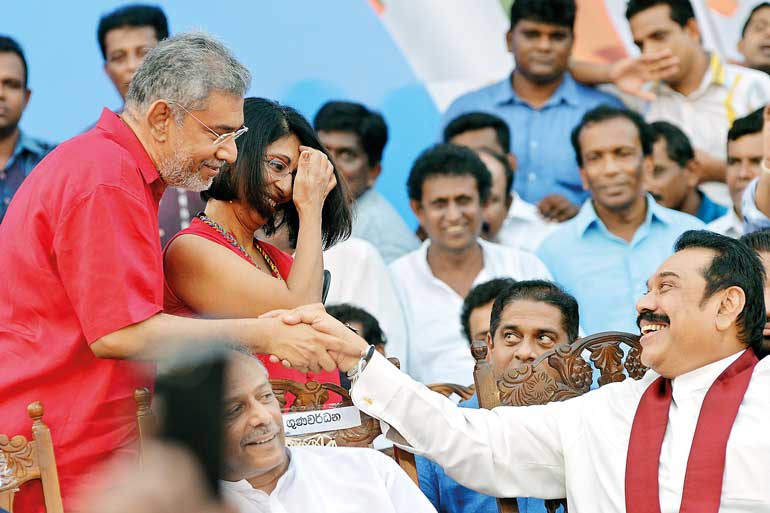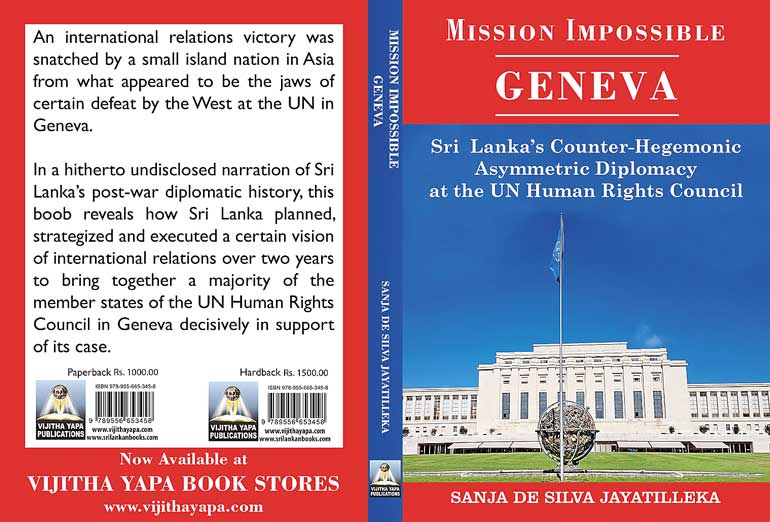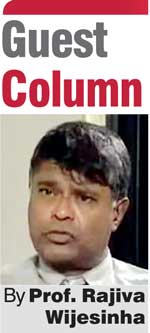Thursday Mar 13, 2025
Thursday Mar 13, 2025
Saturday, 21 October 2017 00:00 - - {{hitsCtrl.values.hits}}

‘Mission Impossible – Geneva’ is an inspiring account of developments at the Human Rights Council in Geneva when Dayan Jayatilleka was our Permanent Representative there. It is written by his wife Sanja, which provides for fascinating insights about the manner in which he planned how to overcome the threats from Western nations that seemed designed to stop us eliminating the terrorist threat within Sri Lanka of the LTTE.
The book is essential reading for anyone who believes that Sri Lanka needs a coherent and effective foreign policy if it is to withstand the multiple threats a small country faces. These are exacerbated by our situation, and the developing dynamics in Asia with continuing interference by the United States to preserve what it sees as its rightful hegemony.
Sanja brings to bear keen analytical skills as well as lyrical passion, which makes the book both enjoyable and instructive. She relieves the tension of her account of what happened in May 2009 with a moving account of her and Dayan walking in their garden, ‘discussing the situation…There was a wondrous little pond on the side, which provided the most pleasant surprise when I first came across it, for it was filled with pink lotus flowers in full bloom…it was restful to sit by the pond taking in the tranquillity they offered’.
Heaven knows Dayan needed to relax, for this was when the European Union tried to have a Special Session of the Council, obviously to stop our armed forces from dealing with the LTTE while continuing what they had achieved in April, liberating vast numbers of those the LTTE held hostage.
Dayan had foreseen this coming, since when he went to Geneva in June 2007 there was already a draft resolution ‘against Sri Lanka, accusing it of War Crimes…tabled in 2006’. He dealt with this expeditiously, and the British ambassador, who had put forward the resolution, told me in December when it was clear he did not have enough support, that Dayan had won. But we would see what would happen later, he said, a warning of the sort the American Ambassador told Tamara Kunanayakam when she too first arrived in Geneva and found the Canadians plotting against Sri Lanka at the behest of the Americans.
Kshenuka Seneviratne, Tamara’s predecessor, had known about the plot but failed to inform Colombo and Tamara had to get through direct to the President to get authority to respond. She did, very effectively, but then she too was undermined in Colombo, just as Dayan was.
But Dayan at least managed to survive in authority for the two years needed to ensure that the Sri Lankan forces did the job that has brought such relief to the country. He succeeded through both intellectual capacity and a brilliant understanding of how foreign relations should be conducted. This involved building up both trust and gratitude.

For the latter he needed to keep up a constant flow of information, and I am glad Sanja pays tribute to his excellent IT officer who built up a website that rapidly became the most visited site in Geneva. Sadly this collapsed completely under Dayan’s successor, and the world receives information about Sri Lanka at the whim of the Western world as had been the practice before Dayan went to Geneva.
Typical of the manner in which foreign relations were and are conducted was the advice given to the President that he should not face the media. This made no sense in the case of Mahinda Rajapaksa, who can communicate effectively in English, but whose officials frighten him in this regard – as indeed happened recently with the interview by the Indian journalist Padma Rao, which I had to press for several times at her request before he agreed (to what seemed his great satisfaction afterwards).
Similarly the Ministry makes a fetish of not responding to NGOs, even though it is clear that what they say has a tremendous impact. But in Dayan’s time, which proved crucial in winning over votes when we needed them, his strategy was ‘so effective that when various NGOs accosted Ambassadors in the lobby to spread misinformation, they brushed them aside and walked on or were able to counter them themselves’.
What Sanja’s book makes clear then is that the first obstacle Dayan had to overcome was not just the ham-fistedness but also the jealousy of the Foreign Ministry establishment. But she is quite clear about the enthusiasm with which those who worked for Dayan adopted the strategy he proposed, and again it is heartening to read of the skill with which his Deputy Ameer Ajwad, now in Singapore, operated.
Secondly, Dayan had also to face the unremitting hostility of the West, or rather at that stage, of the British, who led the Europeans – and were joined with greater enthusiasm by the Americans after Hillary Clinton took over their foreign policy. And in this regard Dayan was hampered by the slavishness of the Sri Lankan establishment to the British, as represented most obviously by Kshenuka Seneviratne, who was reported to have complained about Dayan’s strictures on David Miliband (and managed to get her uncle Manik to introduce a nasty critique about him into the ‘Sunday Island’ – which led to a strong rebuke by the daily ‘Island’, which was much more committed then to defeating the Tigers).
The critique made reference to the defeat we suffered in New York, when the usual ham-fistedness of our diplomats resulted in us not being re-elected to the Human Rights Council. Part of this was continuing slavishness to the British as ably highlighted by the British intellectual Kath Noble (so that they defeated Spain for a seat on the Council, at a time when the southern Europeans were much more sympathetic towards us as exemplified by Dayan’s friend the Portuguese Ambassador in Geneva who formally but revealingly kept him abreast of British manoeuvres).
The foreign policy establishment had a champion in the then Minister Rohitha Bogollagama, who did not let Dayan go to New York, contravening the practice whereby our representative in Geneva attends meetings of the Third Committee in New York. Given the close relations Dayan had established with most countries in the Third World, it is probable that he would have won over enough votes to have us elected, whereas the contempt our established diplomats evinced for our peers obviously had its effect.
Thirdly, Dayan had to deal with obvious prejudice against us amongst Western officials at the Office of the Commissioner of Human Rights. The worst and most influential of these was Rory Mungoven, who had adopted a patronising proconsular role in Sri Lanka when he had been stationed in Colombo and earlier governments had in effect allowed him to dictate with regard to Human Rights issues.
In passing I should note that, on his first visit to Sri Lanka when I headed the Peace Secretariat, he rather oilily suggested that the Norwegian-headed Sri Lanka Monitoring Mission was incompetent and should be replaced by the UN (similarly Gareth Evans, during his vulgar lecture supposedly to commemorate Neelan Tiruchelvam but used to promote his Responsibility to Protect concept, had made a pitch for his outfit to take over from the SLMM).
Sanja’s account of how Dayan dealt with Rory’s pretensions is instructive, for his response to the High Commissioner led to ‘a conciliatory letter, regretting that the fax was not more appropriate’. Again I should note that Rory tried, when High Commissioner Louise Arbour visited Sri Lanka, to have her address the press on her own, contrary to her commitment to the Human Rights Minister Mahinda Samarasinghe – which would doubtless have led to problems as had happened when the same had happened with John Holmes, the UN Under-Secretary for Humanitarian Affairs, who had seemed to be highly critical of the government then, whereas the rest of his visit had passed off well.
Sanja’s account of the manoeuvrings of the OHCHR with regard to our Universal Periodic Review is also fascinating, and makes clear the prejudices we had to overcome. That Dayan did this so successfully when the West sought to stop our military successes, and to punish us when we eliminated the LTTE on Sri Lankan soil, then forms the bulk of the book, but I believe exploring that adventure requires another article.
I shall conclude this article with mention of another major obstacle Dayan faced, which was the unremitting hostility of Israel. Given the intellectual and strategic lead he had begun providing to the vast majority of the Third World who were opposed to the continuing oppression of the Palestinians, the Israelis were determined to get rid of Dayan, and spared no pains to get their point across to the government. For this purpose the Israeli government whined continuously, a strategy that works as I have seen, for instance with Faiszer Mustapha who strove successfully to convince the President that he was unjustly persecuted.
Sadly that strategy on the part of Israel seems to have worked with the former President too, though there were also other reasons for him finally giving in to pressure and getting rid of Dayan. The letter of the Israeli ambassador which nearly prompted Dayan’s sacking early in 2009 shows clearly how the technique is deployed. But our tragedy is that our officials succumbed to this, and never thought of asking our supposedly good friend why they had also at one stage trained the LTTE.
Had Dayan been removed then, it is not difficult to imagine what would have happened to us later that year, as our forces pushed to take over the last remnants of Tiger territory and the diaspora conducted a vigorous propaganda campaign with both Miliband and Clinton repaying the electoral debts they had contracted. Fortunately, though Palitha Kohona had failed to defend Dayan vigorously, the President resisted pressures at that stage – only to succumb six months later and precipitate the crisis that has beset us internationally since.
- pix by Shehan Gunasekara
Discover Kapruka, the leading online shopping platform in Sri Lanka, where you can conveniently send Gifts and Flowers to your loved ones for any event including Valentine ’s Day. Explore a wide range of popular Shopping Categories on Kapruka, including Toys, Groceries, Electronics, Birthday Cakes, Fruits, Chocolates, Flower Bouquets, Clothing, Watches, Lingerie, Gift Sets and Jewellery. Also if you’re interested in selling with Kapruka, Partner Central by Kapruka is the best solution to start with. Moreover, through Kapruka Global Shop, you can also enjoy the convenience of purchasing products from renowned platforms like Amazon and eBay and have them delivered to Sri Lanka.
Discover Kapruka, the leading online shopping platform in Sri Lanka, where you can conveniently send Gifts and Flowers to your loved ones for any event including Valentine ’s Day. Explore a wide range of popular Shopping Categories on Kapruka, including Toys, Groceries, Electronics, Birthday Cakes, Fruits, Chocolates, Flower Bouquets, Clothing, Watches, Lingerie, Gift Sets and Jewellery. Also if you’re interested in selling with Kapruka, Partner Central by Kapruka is the best solution to start with. Moreover, through Kapruka Global Shop, you can also enjoy the convenience of purchasing products from renowned platforms like Amazon and eBay and have them delivered to Sri Lanka.